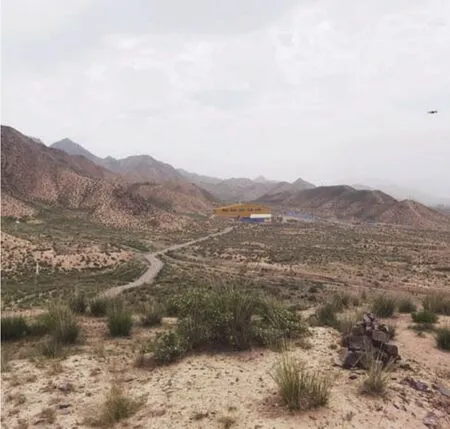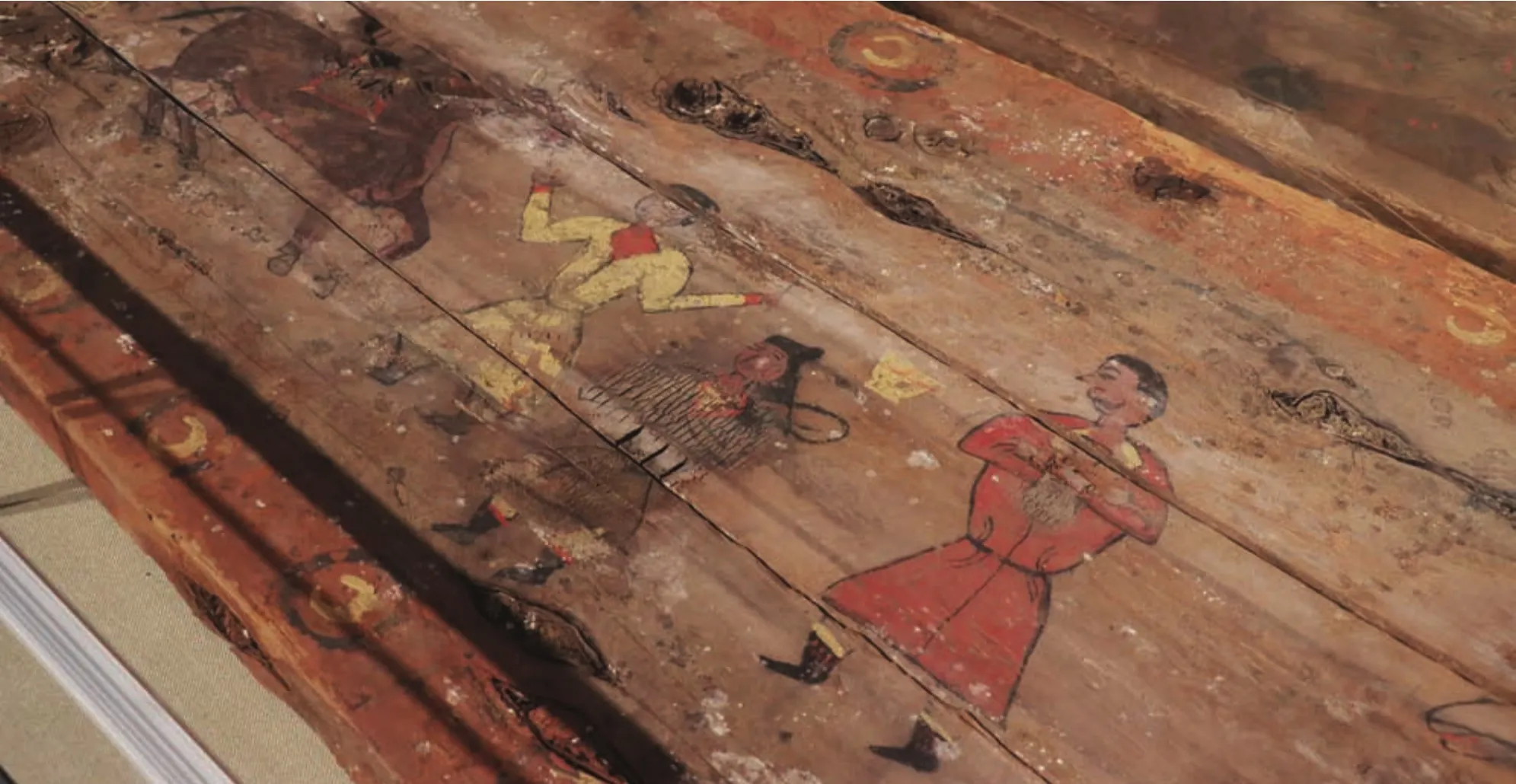西海云长 民族融合
2022-08-26陈架运陆芳芳
文/陈架运 陆芳芳

青海省海西州都兰县海寺花海。Sea of flowers at Dulan county, Haixi Mongolian and Tibetan autonomous prefecture, Qinghai province.
丝绸之路是人类历史上的一个重要通道,为东西方文明的交融、人类文明的进步作出了巨大贡献。
丝绸之路并不是一条固定不变的、单一的道路,它是一张鲜活的、错综复杂的路网;它也并非一直畅通无虞,受战争、政权更迭、气候变迁等因素影响,在不同的历史时期,其发展的重点与走向也不相同。
本届“2022丝绸之路周”特别邀请了青海省作为主宾省,同时,在中国丝绸博物馆推出以丝绸之路青海道为主题的“西海长云:6—8 世纪丝绸之路青海道”大展,吸引了无数参观者,成为活动一大亮点。
说起“丝绸之路”,人们往往会联想到“河西走廊”,但其实从益州(今四川成都)到西域有一条通行历史悠久、几乎与河西走廊并行的道路—青海道。在十六国时期,河西走廊的交通常因战乱而中断,青海道便承担起了作为东西交通枢纽的重任。由此,当时的青海道是文化交流的十字路口,在各民族间的文化交流中起到了举足轻重的作用。
可以这么说,青海道在相当的一段历史时期内,地位并不逊于“河西走廊”;20世纪80年代开始青海道上的众多重大考古发现,尤其是都兰宝地的文明遗迹,更是惊艳世界。而如今的青海道,不仅有饱经风霜后沉淀下来的深厚历史人文底蕴,更在来自各地援建队伍、文化考古专家们的支持、帮助下,焕发着勃勃生机,在西部大发展中扮演着重要角色。
古代丝绸之路上的青海道与民族融合
青海道的开拓历史悠久,最早可以追溯到新石器时代晚期。考古学家在青海发现的大量如马家窑文化和齐家文化遗存表明,当时以湟水流域为中心,青海地区已有交通路线通往西域和中原,因此也有学者建议此时应叫“玉石之路”。秦汉时期,这段道路称为“羌中道”,虽然相对不那么显赫,但是很多故事都早早地与它产生了似有似无的微妙联系。张骞第一次出使西域时,在大夏(今阿富汗)见到来自身毒(今印度河流域一带)的蜀布与邛竹杖,回程时为避免匈奴拦截,就选择绕道青海。
唐代著名诗人李贺有一首诗,生动再现了古丝绸之路青海道:“天含青海道,城头月千里。”青海道有着久远的历史,一直商旅不绝,但在大多数历史时期,它只是作为丝绸之路的辅道而存在。然而,事实上,兴盛期的青海道具有与河西走廊线同等重要的枢纽地位,甚至一度超过了河西走廊,发挥了主道的作用。
它的鼎盛时期是在南北朝。此时的青海道,也称“吐谷浑道”“河南道”(指经青海贵德、循化的黄河以南地区,也指南北朝时期吐谷浑王国封地),这与吐谷浑民族崛起的历史息息相关。
吐谷浑民族是公元4世纪初至7世纪中叶对西北地区尤其是青海历史产生了极为深远的影响的一个重要民族,它所建的政权前后存在了350年。“吐谷浑”原为辽西鲜卑慕容部首领涉归的庶出长子之名,公元4世纪初,因争夺马场而与兄弟失和,他率其部跋涉万里从辽河流域来到了西北的甘青地区。迁徙到西北以后,吐谷浑部征服了原本在当地占主导地位的羌族部落,在与当地羌、氏、汉、匈奴等族长期共同生活与互相交往的过程中,逐渐融合形成为吐谷浑族。
吐谷浑依托控制丝绸之路青海道的优势,一直充当着丝绸之路青海道上中西客商的向导、保护者,以及贸易中继人和翻译的角色,使其联结起南朝与西域间的政治、经济和文化,一度发挥了中西陆路交通主干道东段主线的作用。

1.[唐]鎏金银凤鸟。都兰县博物馆藏。 2.[唐]绿松石金耳坠。都兰县博物馆藏。 3.[唐]金耳饰。都兰县博物馆藏。 4.[唐]金盅座。都兰县博物馆藏。1. Gilt silver phoenix (Tang), collected at the Dulan County Museum. 2. Gold earrings with turquoise stones (Tang), collected at the Dulan County Museum.3. Gold earrings (Tang), collected at the Dulan County Museum.4. Gold cup holder (Tang), collected at the Dulan County Museum.
直至今日,以这一时期为代表的西域与中原使者、商人、僧侣频繁往来其间的文献记载不胜枚举。此外,西宁市区内发现的在中世纪的中亚和西亚占有国际货币地位的波斯萨珊王朝银币,以及都兰县香日德出土的罗马拜占庭时期金币,都能证明这一时期青海道的繁荣状况。
公元6世纪,兴起于青藏高原的吐蕃民族势力扩张,于663年彻底攻灭吐谷浑国。吐蕃为加强对吐谷浑王的笼络与控制,在原吐谷浑故地以和亲形式,强化与吐谷浑王族的甥舅关系,授吐谷浑王承袭“莫贺”之号,统辖吐谷浑各部。但大量吐谷浑人依然生活在青海湖西一带,许多吐谷浑贵族在吐蕃的统治下,依然经营和守护着丝绸之路的青海道,这条道依然可以称为吐谷浑道。安史之乱后,吐蕃控制了青海大部分地区,此时,吐谷浑道和唐蕃古道同时成为丝绸之路青海道的最为重要的丝路干线。
此后,宋、金、西夏、蒙古汗国、明、清相继统治青海地区,该地呈现出多民族聚居、多种宗教并存发展的格局。在各个历史时期,羌、鲜卑、吐谷浑、吐蕃等各民族人民都积极参与了青海道的开发、维护和利用。中华民族和中华文化正是在这种持续不断的民族和文化的交流融合中得以形成和繁盛。
青海道上最闪耀的焦点是热水
如果说古丝绸之路上,青海道彰显着重要的作用,那么,在青海道上,都兰热水就是最闪耀的焦点。
1982年5月,考古专家许新国在夜间调查岩画,偶然发现了雄伟壮观的墓葬封土堆,尤其是被当地人称为“九层妖楼”的“热水一号大墓”最为不凡,自此掀开了都兰热水,即吐谷浑—吐蕃时期(6—8世纪)大型墓葬群的考古序幕。
随后的数十年里,除了青海省考古研究所持续发掘,北京大学和中国社会科学院考古研究所等各个专业团队也陆续加入热水考古队伍。经过一代又一代考古人艰苦卓绝、耕耘不缀的努力,这一青海境内面积最大、保存最多的墓葬群成果不断涌现。
追随着吐谷浑西迁的脚步,今人找到了“都兰”(蒙古语意为“温暖”),一个隶属于青海省海西州,柴达木盆地东南边缘的小县城。而千年前的都兰,是丝绸之路古青海道上的重镇,是吐谷浑—吐蕃统治时期的腹心之地。
彼时,丝路繁华,王朝鼎盛;千年后,都兰境内依然留存珍宝无数。出土的金银器、美玉宝石、丝绸、漆器、金银外币不计其数,精美程度为世所罕见。许新国对自己在1982至1985年主持挖掘都兰血渭一号墓的情景仍然记忆犹新:“那次我们出土最多的就是各种丝绸,像是金锦、缂丝、嵌合组织显花绫、素绫、絣锦等共计350件残片,不重复图案的有130多种,其中112种为中原织造,18件为中亚、西亚织造。那件中古波斯使用的钵罗婆文字锦尤为珍贵,织锦上的文字后来由德国哥廷根大学的专家破译,意为‘王中之王,伟大的,光荣的’。”
这些珍宝有日用品,也有饰品,工艺精湛,艺术价值极高,展现了波斯、希腊、吐蕃、吐谷浑等多元文化风格。如体现吐蕃时期贵族日常生活的人物金片、充满动感和游牧风情的金奔鹿、手持西方来通杯的人身鱼尾金片、萨珊波斯风格的玛瑙十二曲长杯、飞传赞普闻的金凤鸟,等等。集天地之精华,吸收东西方之美学,它们是真正的物之华、天之宝,生动重现了东西方物资交流、文化交融的盛况。
1983年,热水一号大墓被评为“全国六大考古新发现”。1997年,都兰吐蕃墓群被评为“1996年全国十大考古新发现”。2021年,青海都兰热水墓群2018血渭一号墓发掘入选“2020年度全国十大考古新发现”;都兰热水墓群入选中国“百年百大考古发现”。值得一提的是,2018血渭一号墓是热水墓群乃至青藏高原上发现的布局最完整、结构最清晰、形制最复杂的高等级墓葬之一,是中国古代陵墓制度考古的重大发现。其中发现的墓园祭祀建筑、殉牲坑、五神殿的墓室结构、壁画、彩棺,还有出土的大量精美文物等,对研究唐(吐蕃)时期热水地区的葬制葬俗及唐朝时期与少数民族关系史、丝绸之路交通史、物质文化交流史等相关问题具有重要价值。棺床、主墓室东西两壁用涂红彩的斗栱构件装饰、五色石、大量丝织物等都带有明显中原文化特征,充分证明了丝绸之路青海道的物质文化交流盛况,体现了中原文化强大的辐射力及影响力,反映了中华文明由多元到一体的历史演变过程。

热水一号大墓上拍摄的血渭一号墓。李娇俨/摄The No. 1 tomb at Xuewei cemetery. Photo by Li Jiaoyan.
“之江水”流入青海道是东西部合作典范
2022年,不仅是都兰热水考古40周年,也是第四批浙江援青干部千里援建都兰结硕果的一年。如何让更多人知道青海都兰的名字,了解到热水墓群在丝路上的重要性?这些问题始终萦绕在浙江驻都兰援青干部们的心中。经济援建,援青干部们早有规划并胸有成竹,但是要把无形的文化援青工作做得精彩,则成为需要他们不断摸索探路的新课题。
浙江省境内最大的河流钱塘江,因江流曲折,被称之为“之江”。新时代推进西部大开发形成新格局,对于推动西部地区高质量发展、决胜全面建成小康社会、开启全面建设社会主义现代化国家新征程具有重要意义。这几年来,浙江对口援助青海海西州,在都兰所在的海西州设立了援青指挥部,让“之江水”源源不断地“流”向海西州。同时,在文物考古领域,浙江的学术机构和学者很早就和青海特别是与都兰开展了密切合作。
2022年7月12日,“丝路上的都兰:热水考古40周年回顾”展览在都兰县博物馆开幕。展览由中国丝绸博物馆策划,以热水墓群为主体,以考古发掘为时间脉络,分设“艰辛历程”“煌煌印记”“硕果累累”“重大意义”四大单元,从考古过程、考古成果、学术研究三个角度出发,聚焦墓葬形制、棺板画、丝织品、金银器、藏文木牍等多元文物资源,回顾了40年来都兰境内与吐谷浑—吐蕃文化遗存相关的考古发掘过程,展现热水墓群考古对丝绸之路青海道研究、中国多民族多元一体发展的重大意义。其中,还特别展出了由国丝技术部修复的元代海青衣。
当看到都兰人携家带口在展柜前细细欣赏、专家学者凝神研究、各地游客惊叹连连、青海道的名字一次次出现、璀璨夺目的都兰珍宝秒杀无数菲林时,青海考古人、浙江援青干部、文博策展方、文物修复者的心中满是喜悦与感动:能为千年丝绸之路青海道上的珍贵文化遗存再现荣光而尽一份心,能为在世界面前呈现出都兰的多元文化交融、丝绸之路上的文化共荣而出一份力,是活在当下的国人之幸。
日落昆仑,长云亲吻了雪山,风轻拥着青海湖,心中有爱的文明绵亘万里,不会逝去。

青海省海西州都兰县博物馆。The Dulan County Museum.
Ethnic Integration along the Qinghai Path
By Chen Jiayun Lu Fangfang
The Silk Roads, important passages in history which have made great contributions to the integration of Eastern and Western civilizations and the progress of human civilization, are not fixed, singular routes, but a series of lively and intricate road networks; it is not always smooth, but affected by factors such as war, regime change and climate change, the focus and direction of its development are also different in different historical periods.
We tend to think of the Hexi Corridor as the Silk Road,but in fact, there is a long-standing road from Yizhou (now Chengdu, Sichuan) to the Western Regions, almost parallel to the Hexi Corridor — the Qinghai Path. During 304-439, the traffic of the Hexi Corridor was usually interrupted by wars, making the Qinghai Path a major east-west transportation hub. Lying at the crossroads of cultural exchanges at that time, it played an important role in ethnic exchanges.
The major archaeological discoveries there since the 1980s,especially the cultural relics of Dulan, are amazing to the world.Today’s Qinghai Path not only has a profound historical and cultural heritage accumulated after tribulations, but also, with the support, assistance and care of construction aid teams and archaeological experts from all over China, it is radiating vigor and vitality in the future development of the western region.
The development of Qinghai can be traced back to the late Neolithic Age. A large number of remains such as Majiayao culture and Qijia culture discovered there show that with the Huangshui River Basin as the center, Qinghai area had traffic routes leading to the Western Regions and the Central Plains, which some scholars suggested to be called the “Jade Road”. In 221BC-220AD,this road was called the Qiangzhong Path. Although it was less prominent, many stories had early and subtle connections with it.When Zhang Qian went to the Western Regions for the first time,he saw in Bactria (now Afghanistan) Sichuan cloth and bamboo sticks coming from Sindhu (now the Indus Valley), and he chose to detour via Qinghai to avoid interception by the Xiongnu nomads on his return journey.
The Qinghai Path has a long history for commerce and travel,but in most historical periods, it only served as an auxiliary part of the Silk Roads. However, the Qinghai Path in its prosperous period was as important as the Hexi Corridor, or even more so for a time. The first heyday was in 420-589, when the Qinghai Path was known as “Tuyuhun Path” or “Henan Path” (referring to the fiefdom of the Tuyuhun Kingdom, i.e. the area south of the Yellow River through Guide and Xunhua in Qinghai), due to the rise of the Tuyuhun ethnic group, which had a profound impact on the history of Northwest China from the early 4th century to the mid-7th century. Tuyuhun was originally the name of a leader of the Murong clan of Xianbei in western Liaoning. In the early 4th century, he broke up with his brother and led his troops to travel thousands of miles to Northwest China. He conquered the Qiang tribe that was dominant in the local area, and living together and interacting with the local Qiang, Yuezhi, Han, Xiongnu and other tribes, they gradually merged to form the Tuyuhun tribe.
Taking advantage of their control of the Silk Roads, Tuyuhun acted as a guide, protector, trade relay and translator for Chinese and Western merchants. To this day, there are numerous records of the frequent exchanges between the envoys, merchants and monks from the Western Regions and the Central Plains. The Sassanid silver coins of Persia, an international currency in Central Asia and West Asia in the Middle Ages, found in Xining, capital city of Qinghai, and the Byzantine gold coins unearthed in Xiangride township, Dulan county, can all prove the prosperity of the Qinghai Path during this period.
In the 6th century, the Tibet nationality from the Qinghai-Tibet Plateau expanded to completely conquer the Tuyuhun state in 663. In order to strengthen control of the Tuyuhun king, Tibet consolidated the relationship with the Tuyuhun royal family in the form of a marriage, and granted the Tuyuhun king to inherit the title of “Mohe” in the former Tuyuhun homeland and govern all the Tuyuhun tribes. However, a large number of Tuyuhun people still lived in the west of Qinghai Lake. Many Tuyuhun nobles still operated and guarded the Qinghai Path under the Tibetan rule. This road could thus still be called the Tuyuhun Path. After the An Lushan Rebellion (755-763), the Tibetans even controlled most of Qinghai.

吐谷浑时期棺板画。Drawings on coffin planks, dated to the Tuyuhun period.
Afterwards, successive dynasties ruled the Qinghai area, which presented a pattern of multi-ethnic settlement and coexistence of various religions. In various historical periods, people of all ethnic groups such as Qiang, Xianbei, Tuyuhun, and Tibetans actively participated in the development of the Qinghai Path. The Chinese nation and Chinese culture were formed and prospered in this continuous exchange and integration of nationalities and cultures.
Therefore, the greatest contribution of the Silk Roads to human civilization lay in the communication between different countries and different ethnic groups, promoting the two-way cultural exchanges between the East and the West. The integration and interaction between the ethnic groups ultimately constituted the general pattern of openness and inclusiveness of the Chinese civilization.
Reshui in Dulan was the most shining focus on the Qinghai Path. In May 1982, archaeologist Xu Xinguo was investigating rock paintings at night and accidentally discovered majestic sealed mounds. “Reshui No. 1 Tomb”, known as the “nine-story demon tower” by the locals, was the most extraordinary. And thus opened the archaeological prelude of the Tuyuhun-Tibetan period (6th-8th century) large-scale tomb group in Dulan. In the following decades, continuous excavations of the largest and best-preserved tomb group in Qinghai continued to reveal Dulan (meaning“warmth” in Mongolian), a small county located in Qinghai’s Haixi Mongolian and Tibetan autonomous prefecture, as a major town on the ancient Qinghai Path a thousand years ago.
Over a thousand years later, countless treasures still remain in Dulan. The unearthed gold and silver ware, jade and precious stones, silk, lacquerware, and foreign gold and silver coins are innumerable and exceptionally exquisite. Xu still remembers the scene when he presided over the excavation of Xuewei No. 1 Tomb in Dulan from 1982 to 1985: “Most articles we found were silk pieces, such as gold brocade, ko-ssu, and interlaced pattern twill damask, simple twill damask and ikat brocade. There are a total of 350 broken pieces of silk, in over 130 kinds of non-repeating patterns, of which 112 were woven in the Central Plains, and 18 in Central Asia and West Asia. The Balaba script brocade used in medieval Persia is especially precious, with the text on the tapestry later deciphered by experts at the University of Göttingen in Germany as meaning ‘the king of kings, the great, the glorious’.”
These treasures include daily necessities and accessories,with exquisite craftsmanship and high artistic value, showing the multicultural styles of Persia, Greece, Tibet and Tuyuhun,for example, sequins of characters embodying the daily life of aristocrats in the Tibetan period, golden deer in a dynamic and nomadic style, sequins of mermaid holding a rhyton, the agate cup in Sasanian Persian style, the golden phoenix flying to report to the Tibetan king, and so on.
